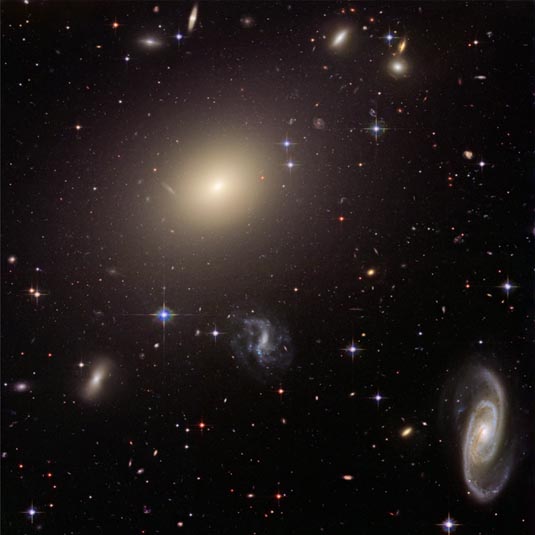
Giant Elliptical Galaxy and its Host Galaxy Cluster
RA 13h 43m 33s.30 Dec. -38° 10' 34".0
Centaurus
Approximately 463 million light-years (142 Megaparsecs)
This image is roughy 2.9 arcminutes (385,000 light-years or 120 kiloparsecs) wide.
ACS/WFC
January 2005/February 2006
NASA, ESA, and the Hubble Heritage Team (STScI/AURA)
February 6, 2007
ABOUT THIS IMAGE:
This image from NASA's Hubble Space Telescope shows the diverse collection of galaxies in the cluster Abell S0740 that is over 450 million light-years away in the direction of the constellation Centaurus.
The giant elliptical ESO 325-G004 looms large at the cluster's center. The galaxy is as massive as 100 billion of our suns. Hubble resolves thousands of globular star clusters orbiting ESO 325-G004. Globular clusters are compact groups of hundreds of thousands of stars that are gravitationally bound together. At the galaxy's distance they appear as pinpoints of light contained within the diffuse halo.
Other fuzzy elliptical galaxies dot the image. Some have evidence of a disk or ring structure that gives them a bow-tie shape. Several spiral galaxies are also present. The starlight in these galaxies is mainly contained in a disk and follows along spiral arms.
Evident from the Hubble image is the fact that ESO 325-G004 is home to thousands of globular clusters, small compact groups of hundreds of thousands of stars that are gravitationally bound systems. These clusters are dispersed spherically and uniformly in the outer halo of the elliptical and make their way around the center of the galaxy over the course of millions of years. Several foreground stars and background galaxies are also visible within the halo of this bright galaxy.
In the course of analyzing this Hubble image, astronomers discovered that the galaxy ESO325-004 is actually a "gravitational lens." This means that the focusing power of the enormous mass making up the galaxy causes the light from some background object, probably a distant "dwarf" galaxy, to be deflected and magnified. As a result, the more distant galaxy appears brighter, and distorted into the shape of an arc, or ring, known as an "Einstein ring" because the phenomenon was first predicted by Albert Einstein. Although the universe is filled with galaxies, gravitational lensing is a rare occurrence because it requires an almost perfect alignment of a distant galaxy with an intervening one that has enough mass to gravitationally focus the light.
This particular system is unique because it is closest known example of strong gravitational lensing. The galaxy is close enough that the dynamics of its stars can be studied in detail using spectrographs on large ground-based telescopes. The spectrographs reveal how fast the stars in the galaxy are moving, and this allows astronomers to estimate how much mass must be present in the center of the galaxy. This estimate can in turn be compared to the amount of mass needed to produce the observed gravitational lensing effect. In this way, astronomers can build up a detailed, self-consistent picture of the matter distribution and dynamics of this unique nearby lensing system.
This image was created by combining Hubble science observations taken in January 2005 with Hubble Heritage observations taken a year later to form a 3-color composite.
Color:
This image is a composite of many separate exposures made by the ACS instrument on the Hubble Space Telescope using several different filters. Three filters were used to sample broad wavelength ranges. The color results from assigning different hues (colors) to each monochromatic image. In this case, the assigned colors are:
F475W
(g) blue F625W
(r) green F814W
(I) red